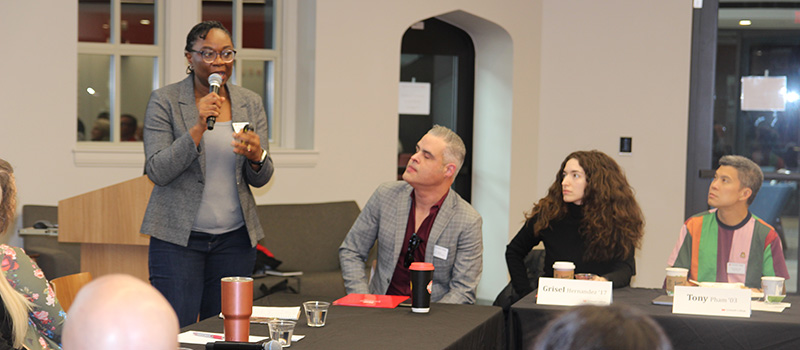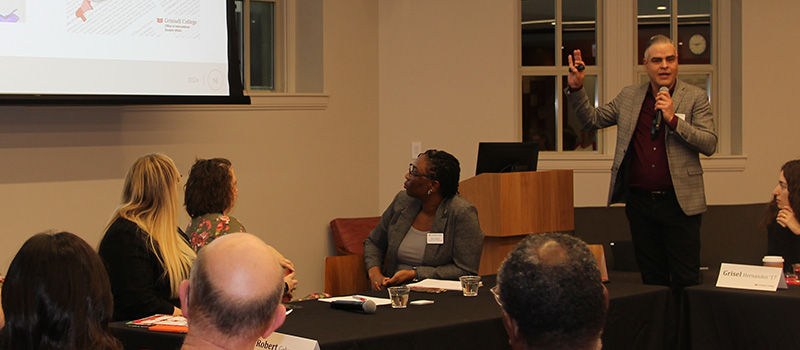Greater belonging and connection felt through new residential life program
April 17, 2025 — A new Grinnell College residential experience that supports student development has already seen a number of positive outcomes.
At the beginning of this school year, Residence Life has launched its Grinnell College Residential Experience (G-CORE) curriculum, which intentionally creates an environment to inspire learning, personal growth, and community connections.
Mfon Nwabuoku, associate director of residence life and student conduct, led a presentation about G-CORE at the Alumni Council’s April 4 on-campus meeting as part of a broader overview about Division of Student Affairs activities.
 Mfon Nwabuoku, associate director of residence life and student conduct, tells the Alumni Council about the G-CORE curriculum.
Mfon Nwabuoku, associate director of residence life and student conduct, tells the Alumni Council about the G-CORE curriculum.
“Overall, students want to engage more and more since G-CORE was implemented” Nwabuoku said. “That’s what we’re looking for. We can see that students like what we’re doing.”
Under the G-CORE program, students can uncover different pockets of Grinnell’s campus, explore connections with fellow resident hallmates, and learn about different resources available to them. This has come to fruition in numerous ways, Nwabuoku said.
Every student is set up to connect with at least one person in their living space. Students hired as Community Advisors (and trained in the G-CORE curriculum) present monthly themes for their residence hall floor. These themes are reflected in the floor’s bulletin boards and events.
Early in the school year, G-CORE inspired students to think about their group identities with a program called “This is Us.” Together, students were tasked to design an emblem or a logo that would represent their identity as a community.
“Belonging and connection has been the first strategic focus for G-CORE,” Nwabuoku says. “All of our objectives can be traced back to building a sense of belonging and connection.”
Belonging and connection is one of the primary values in the College’s Knowledge into Action strategic plan, which went into motion in 2023. The plan strives for students (and other Grinnellians) to have more authentic and lasting connections with Grinnell and with each other in spaces and experiences that facilitate intellectual, experiential, and social communities.
 Alumni Council members listen to JC Lopez, vice president of student affairs, discuss student affairs programs during a meeting in the HSSC on April 4.
Alumni Council members listen to JC Lopez, vice president of student affairs, discuss student affairs programs during a meeting in the HSSC on April 4.
Tied to this pillar of the strategic plan, G-CORE’s work is already building community and connections as students have learned the skills necessary to build meaningful relationships.
Other G-CORE learning goals are personal growth and awareness, co-creating communities, and civic collaboration. A number of programs and events have been held to advance these goals. Examples include a Kindness Day, the All-Campus Jamboree, grocery bingo, and financial wellness lessons.
To incentive attendance, students receive G-CORE points for going to events. These points will allow students to enter an end of the semester prize drawing, where they could win movie tickets, microwaves, AirPods, early room selection, and more. More than 960 students have gone to at least one event, which is about 60 percent of the student population.
Alumni Council member Jay Dick ’93 asked if Residence Life is trying to get to 100 percent engagement, or if they recognize that’s not possible since some students won’t participate. Nwabuoku said 100 percent is definitely their ambition. Student feedback is captured through surveys and other qualitative methods. This is another area where the Community Advisors are helpful.
“We will keep tweaking strategies and having intentional conversations,” Nwabuoku said. “The CA’s have been talking with everyone on their floors and taking note of student voices.”
JC Lopez, vice president of student affairs, said another sign G-CORE is having positive effects is a significant increase in the retention rate of Community Advisors, students who live on each floor and who help promote the curriculum. There were 40 returning applicants and 113 new applicants.
“There’s something there,” he said about the advisors. “They help built so many positive connections and relationships in support of their residents.”
—by Jeremy Shapiro